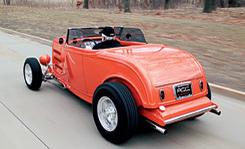 Specialty File
Specialty File
Thousands of 1932 Ford hot rods have been built in garages, driveways, and backyards in this country since the '50s, but this is the first all-steel '32 to be built in volume using contemporary OEM construction techniques and design software.
It's the Dearborn Deuce Convertible, a cooperative venture between Hot Rods & Horsepower of Branford, Connecticut, and ASC of Southgate, Michigan. H&H provides the frames, the suspensions, and the retailing muscle, and ASC designed and builds the heavily modified all-steel body shells using CATIA software, the same as that used throughout the industry.
Originally designed as a small-volume side project for ASC's guys to do during the slow winter months, the Dearborn Deuce Convertible has turned into a serious enterprise, with 154 cars built and orders for 300 more in the bank.
The Deuce Convertible comes to life from a kit, really, and it's up to the buyer how much of the project he or she wants to do. The two companies will sell a body, doors, decklid, and hood to customers who have their own '32 Ford frame; a complete body that has been electrocoated against the elements; or a roller consisting of body, frame, suspension, and electrics, for those who want to drop in a crate motor from Detroit and do their own painting. For a small, well-heeled clientele-including Tom Gale, former design boss at Chrysler, and publishing magnate Keith Crain-ASC will build a complete car to the customer's specifications (one Detroit-area car dealer is having a Deuce built with a supercharged vintage Cadillac engine).
Mark Trostle, the project's director and ASC's president of creative services, has built four rods, including his own '32 Ford roadster. For the Deuce, he changed a few important dimensions to suit today's clientele, three generations taller and fatter than Henry's original customers. The doors are 3.5 inches longer than stock for easier entry and exit, and the cockpit is lengthened about 2.5 inches, but the overall dimensions are spot on.
H&H currently offers two different frames. One has a modern coil-over front suspension and a Jaguar independent rear setup, with inboard disc brakes. The other has front and rear solid axles. In the cockpit, ASC offers a Stewart Warner or reproduction Auburn gauge panel and a choice of steering wheels and shift knobs.
 The car we tested has a traditional five-inch dropped solid axle, radius rods, and transverse leaf springs up front. At the back there's a late-model nine-inch Ford rear end supported by leaf springs. Propulsion is supplied by a GM carbureted ZZ4 crate motor and a Turbo-Hydramatic 350 automatic. The gauge package is a Stewart Warner engine-turned panel, and the steering wheel has three spokes. The Halibrand-style window wheels are by Colorado Custom.
The car we tested has a traditional five-inch dropped solid axle, radius rods, and transverse leaf springs up front. At the back there's a late-model nine-inch Ford rear end supported by leaf springs. Propulsion is supplied by a GM carbureted ZZ4 crate motor and a Turbo-Hydramatic 350 automatic. The gauge package is a Stewart Warner engine-turned panel, and the steering wheel has three spokes. The Halibrand-style window wheels are by Colorado Custom.
The body is built on an ultra-precise set of jigs and locators to meet current OEM tolerance levels. It has a sheet of 1/8-inch steel for the floor paneling, stamped-steel A- and B-pillars, and reinforcements everywhere so the body-panel, door, and hood fits are about as tight as your average Toyota's.
The late-model steering column has a tilt mechanism to clear legs and bellies. Although the Dearborn Deuce Convertible comes fenderless as a proper highboy should, it can be fitted with motorcycle, aftermarket, or original 1932 fenders, if you can find them, because all the dimensions and pickup points have been retained.
Twentieth-century architect Ludwig Mies van der Rohe, whose lines include "less is more" and "God is in the details," would love the Dearborn Deuce. The details and extra touches on the Deuce are just wonderful. Every car comes with power curved-glass windows that mate perfectly with the convertible top. The windows, which the 1932 Ford did not have, are controlled by hidden switches, and electrically operated doors can be opened by underdash switches or by key fob. The body sides are perfectly clean from end to end. There are no door handles, no visible hood latches, and no trunk latch. This baby is smooooth.
This is the only 1932 Ford replica we are aware of that comes with a convertible top that stows away behind the seats. ASC has built more than a million convertibles over the past 40 years, and it knows how to do tops. Reach into the left side panel of the Deuce Convertible to unlock the top hatch, unlatch the top at the windshield header, pull down on the two overcenter latches in the top mechanism, push the rear section of the top forward, open the hatch, stow the top, and push down on the cover till it clicks. One person can do all of this in less than 30 seconds.
The car we thrashed was reassuringly a hot rod. Its solid-axle chassis had a few squeaks and rattles, and its rear suspension didn't like railroad crossings much, but the 2712-pound roadster was a pleasure to drive on good roads, with slow-ratio manual steering and manual brakes, plenty of head-, hip-, and legroom even for tall guys, and an exhaust note that even Pavarotti couldn't match. The Dearborn Deuce Convertible clicked off impressive times: 0 to 60 mph in 4.8 seconds, the quarter-mile in 13.4 seconds at 104 mph. Around the skidpad, it was oversteer time. We managed to keep the rear tires in line for 0.69 g, which is pickup-truck territory. And those manual brakes took 227 feet to stop from 70 mph to 0, not as good as a 6800-pound Hummer H2 SUT [ C/D, January 2005].
For about $90,000 in parts and your own labor-or about $125,000 for the turnkey car here-you can have a Deuce of a time in any color you want.
Hot Rods & Horsepower, 11 Business Park Drive, Branford, Connecticut 06405; 203-481-1932; www.hotrodsandhorsepower.com. ASC, One ASC Center, Southgate, Michigan 48195; 734-285-4911; www.ascglobal.com.